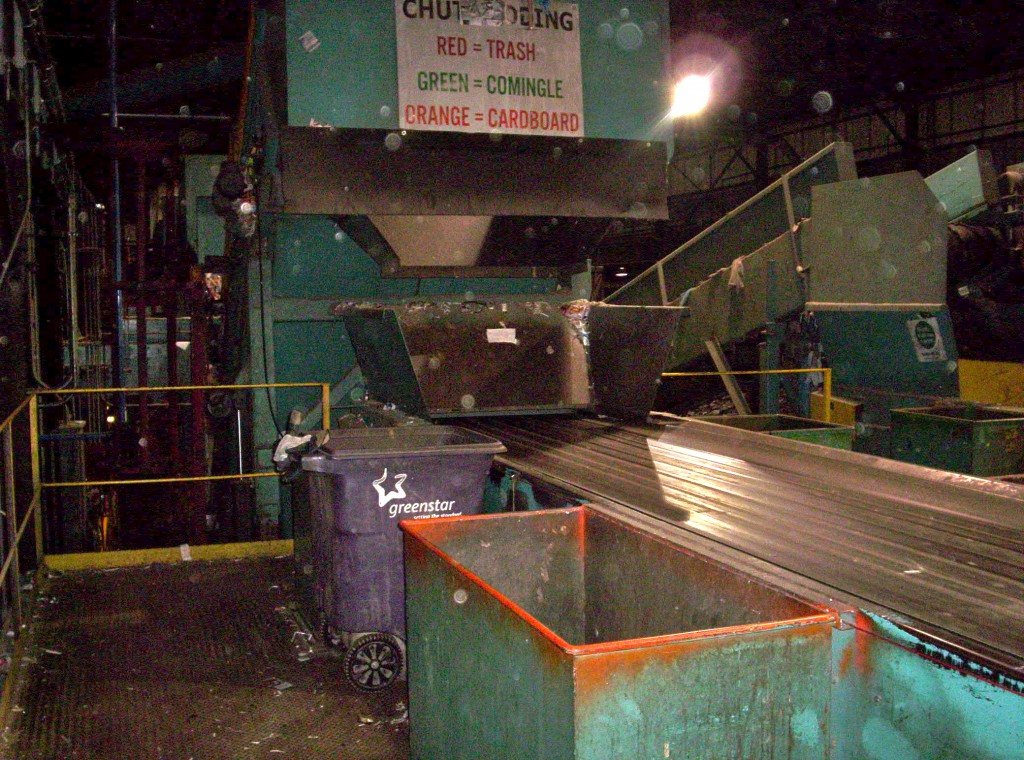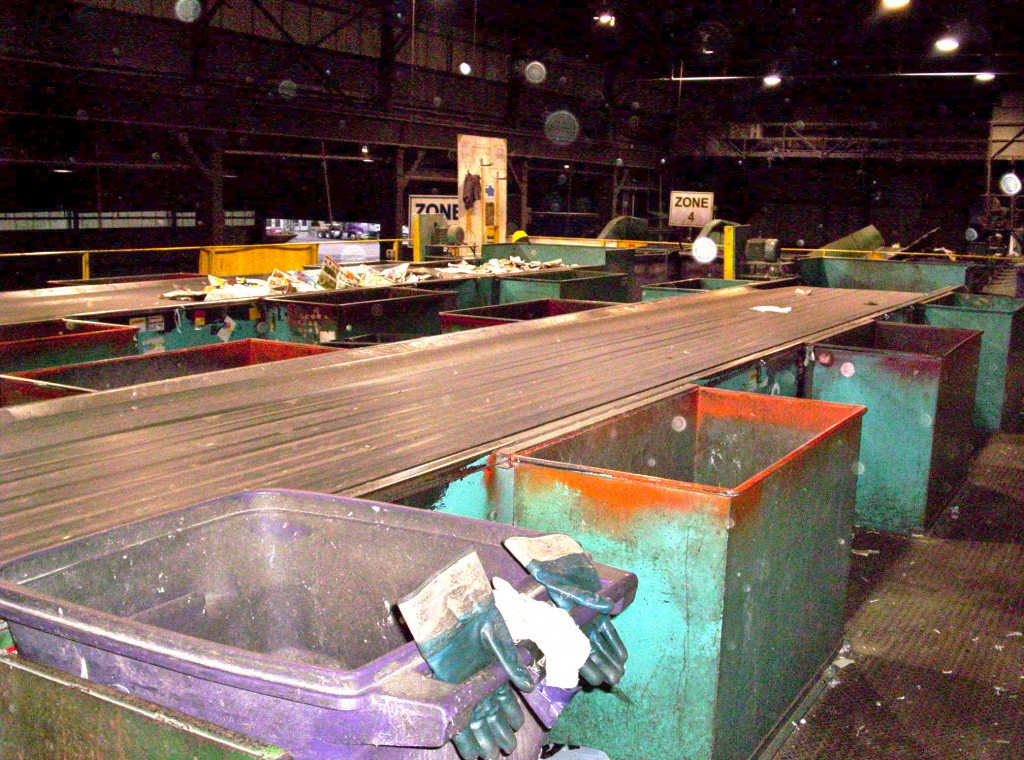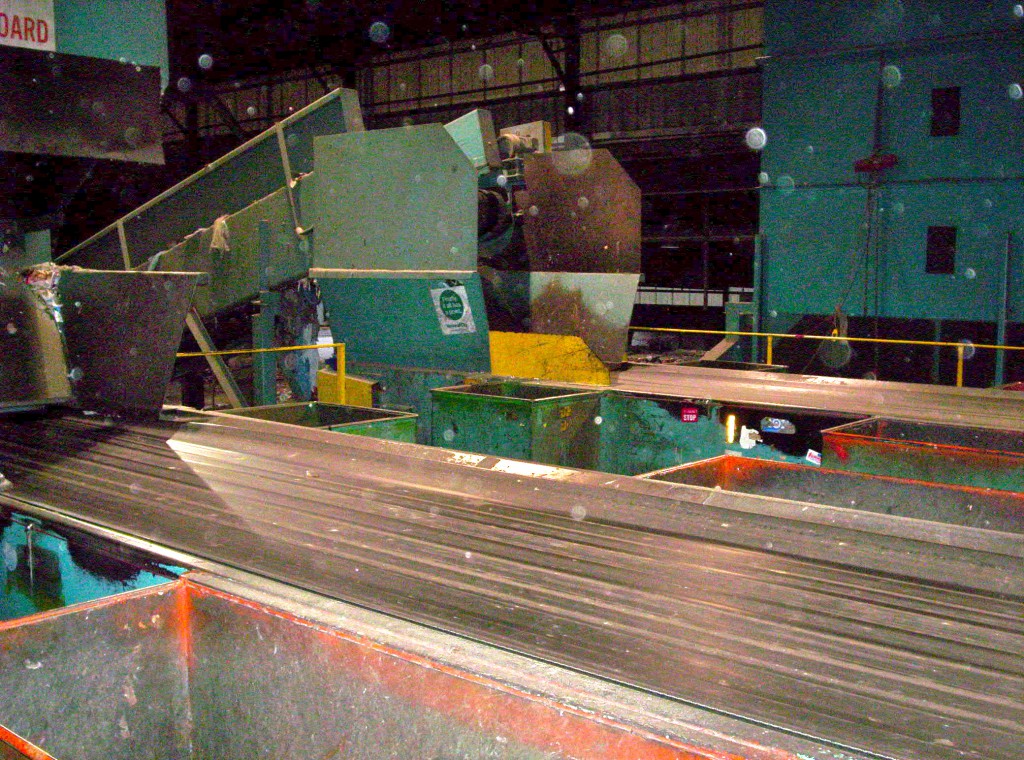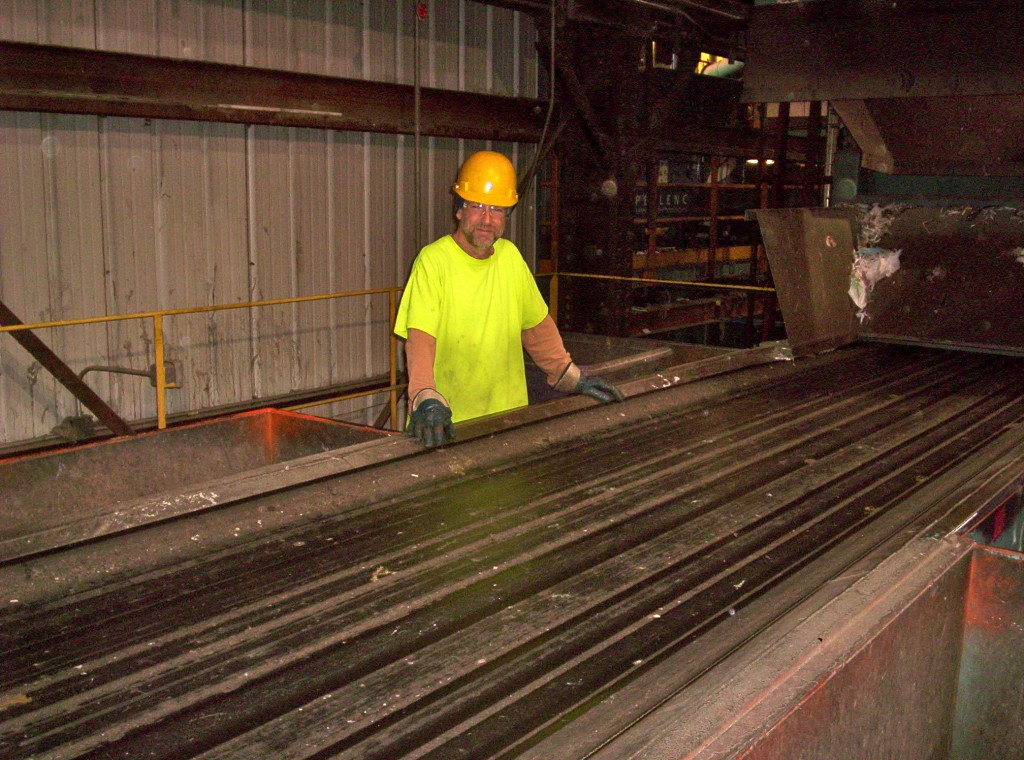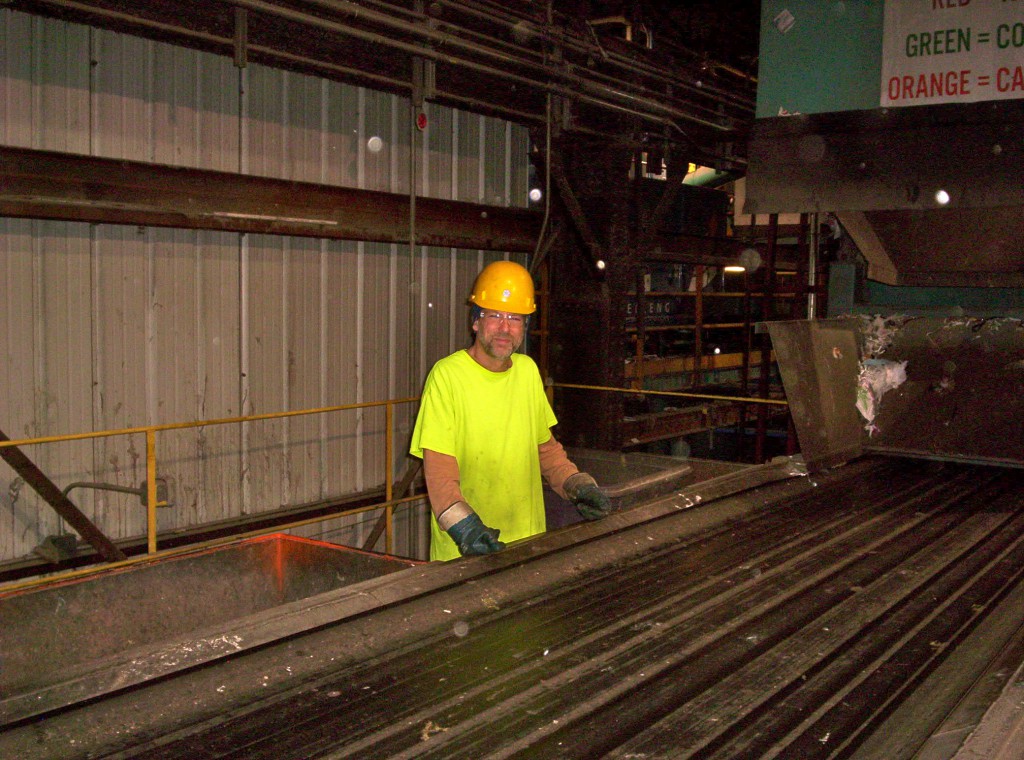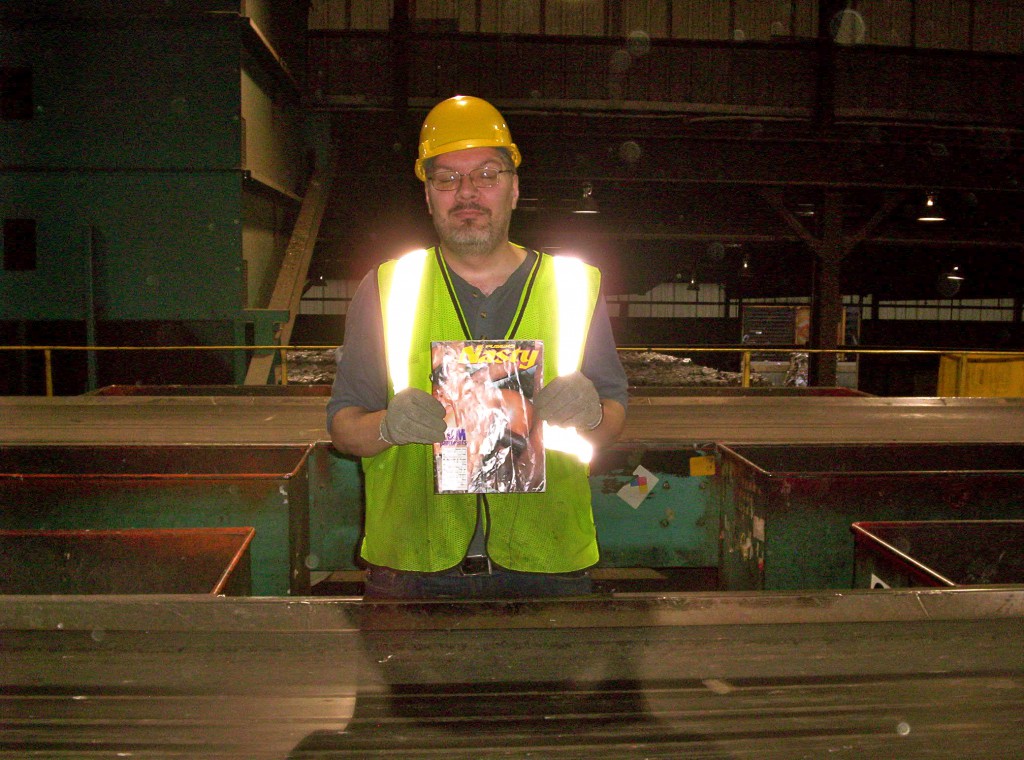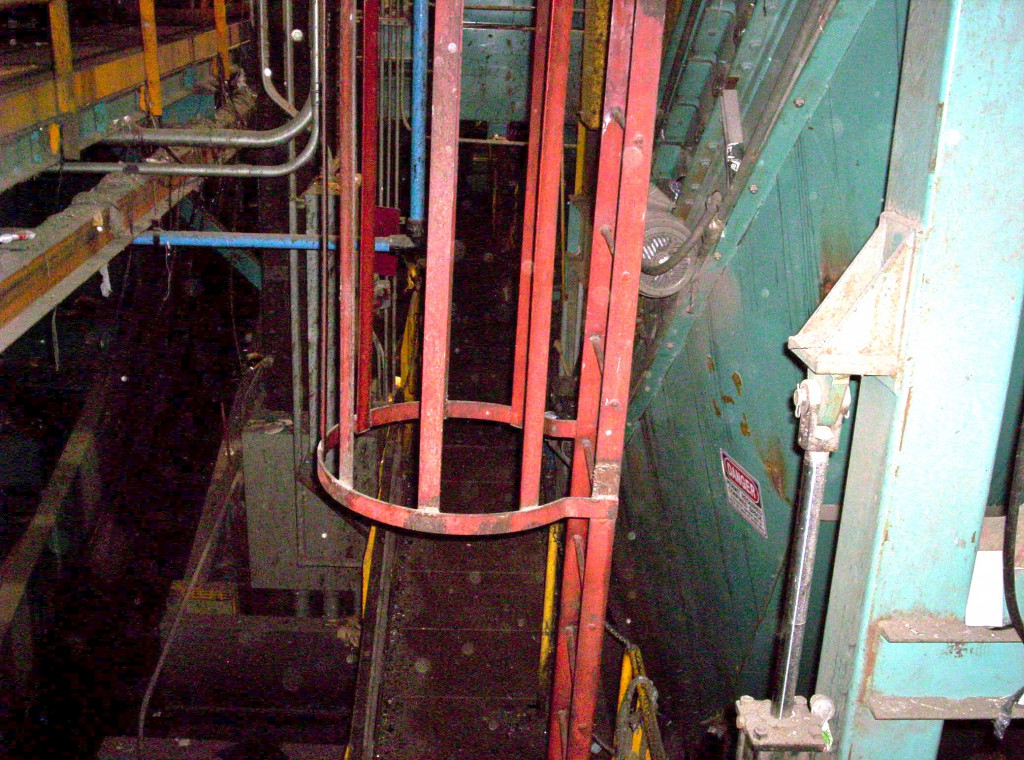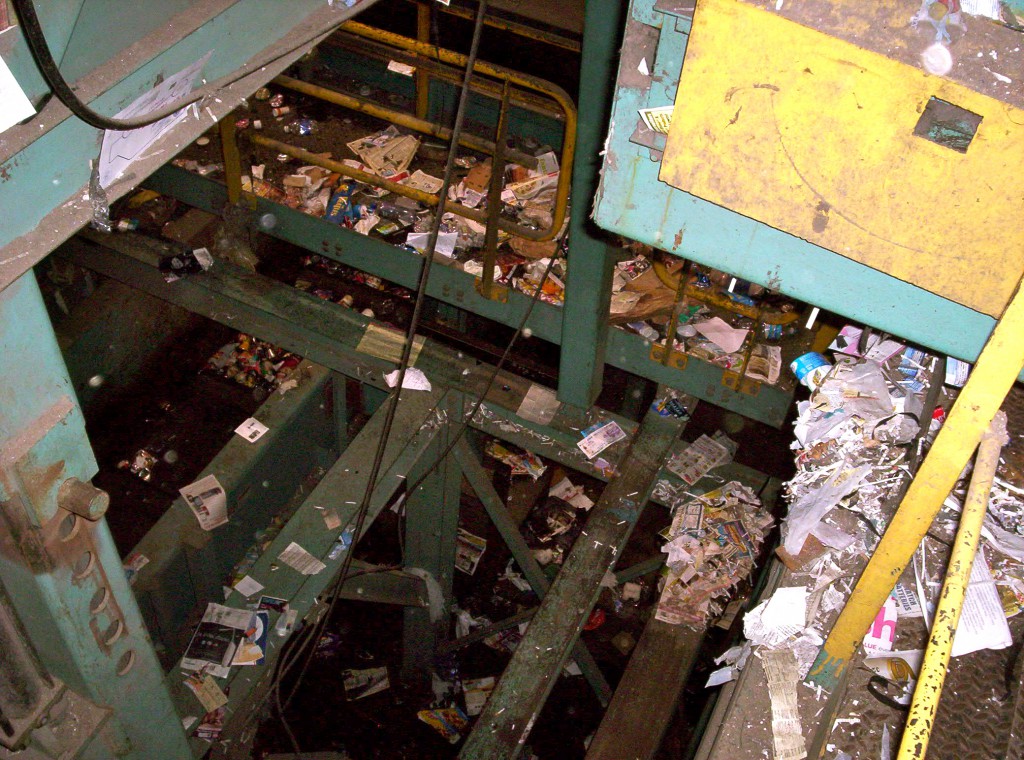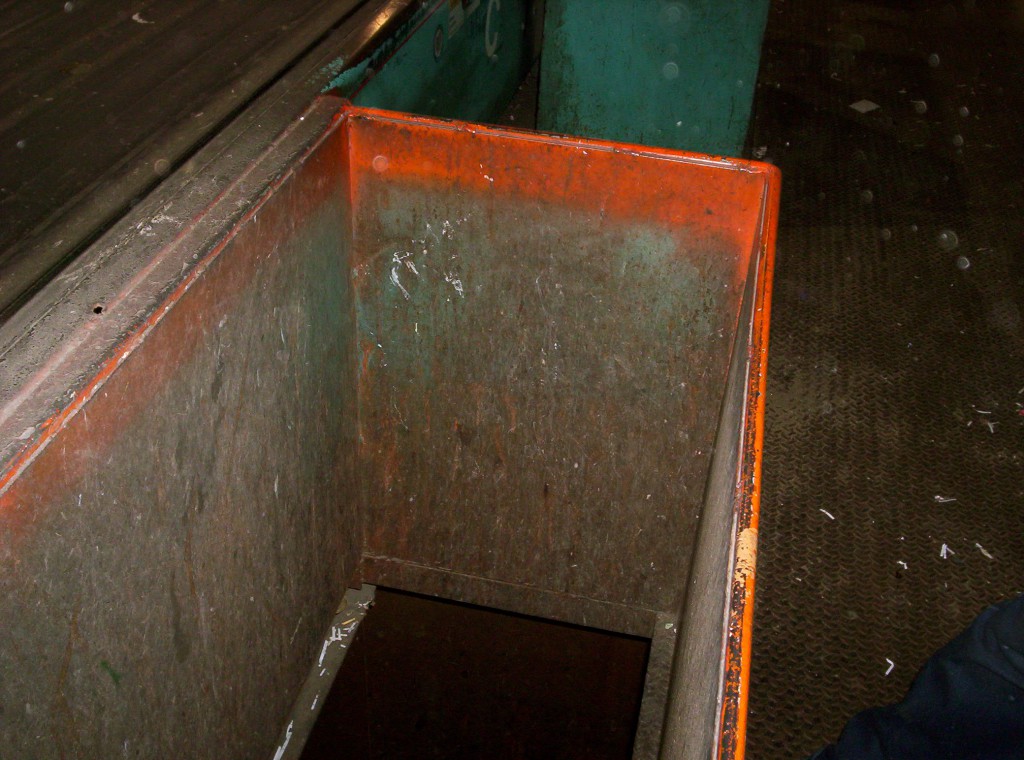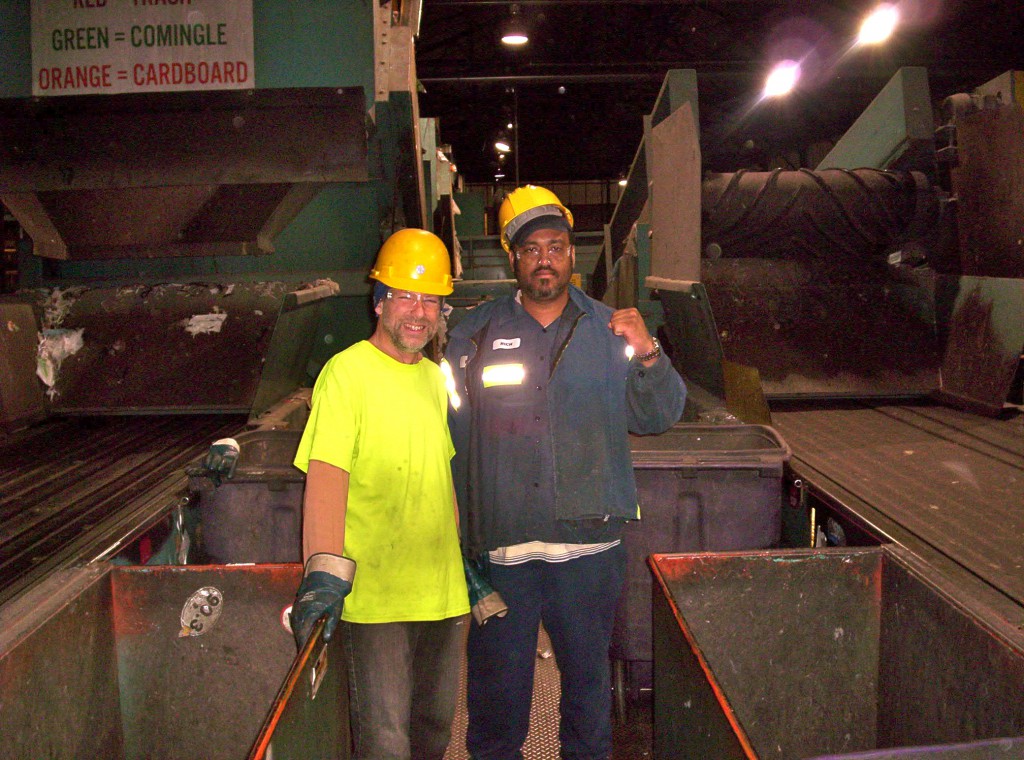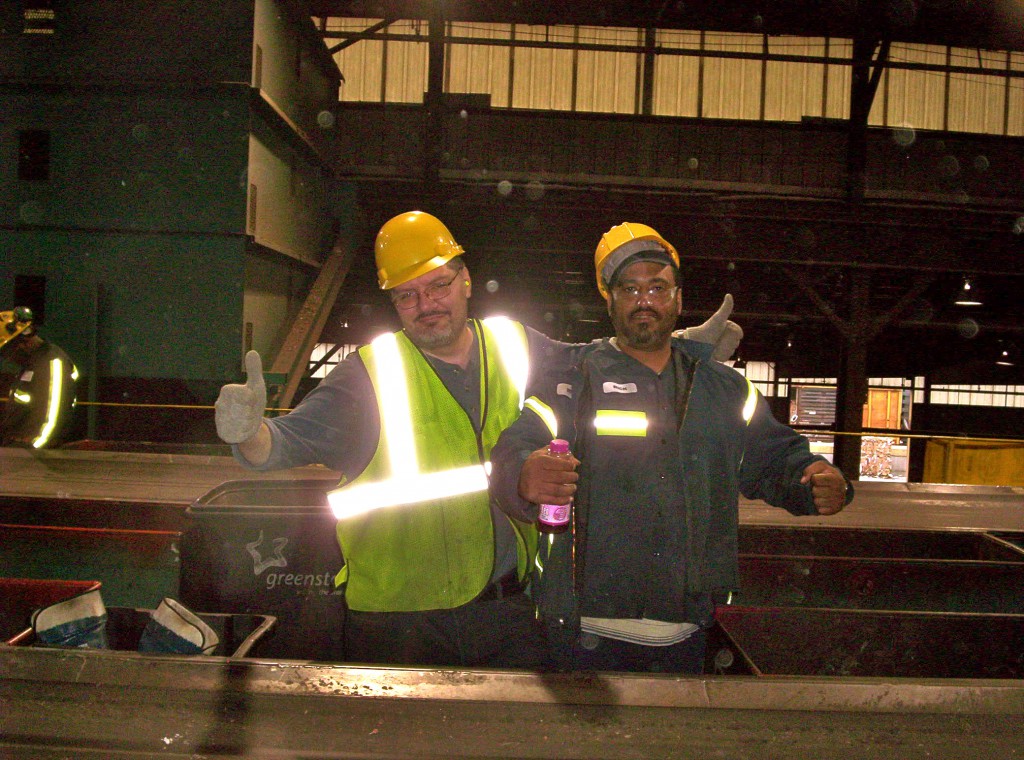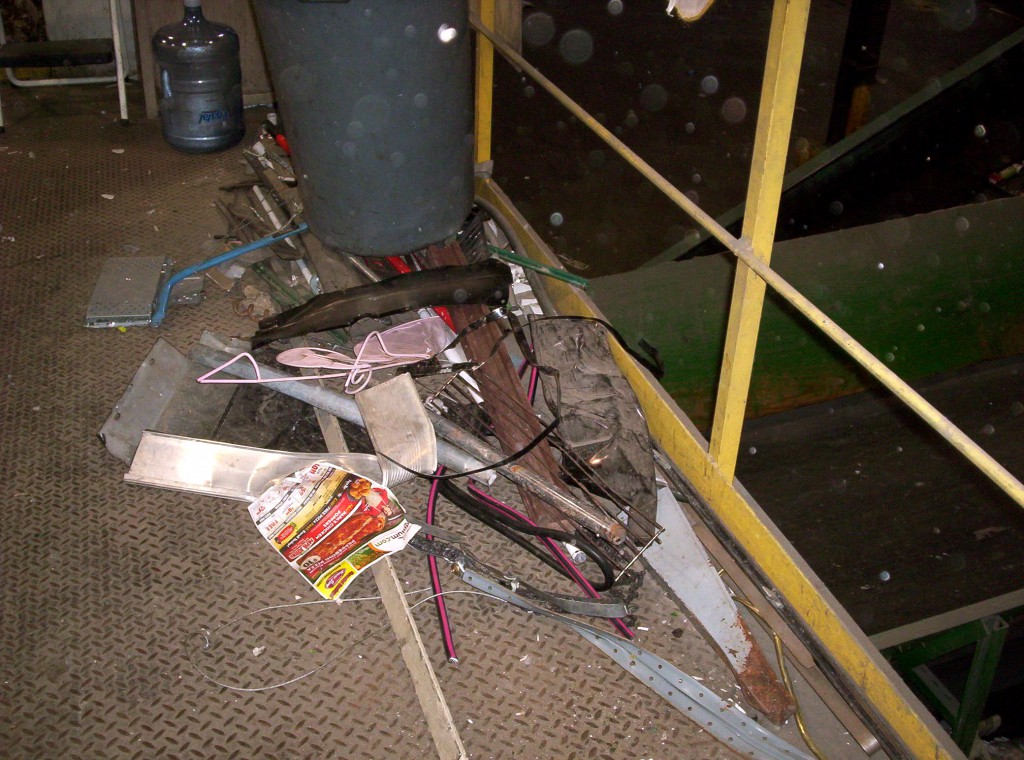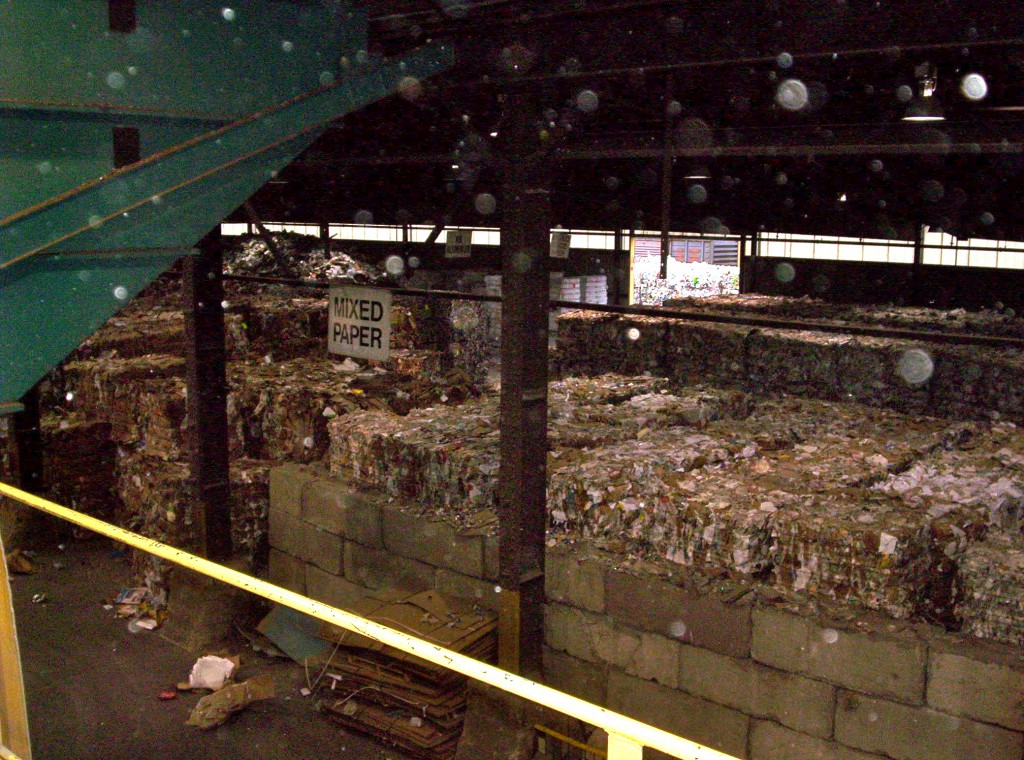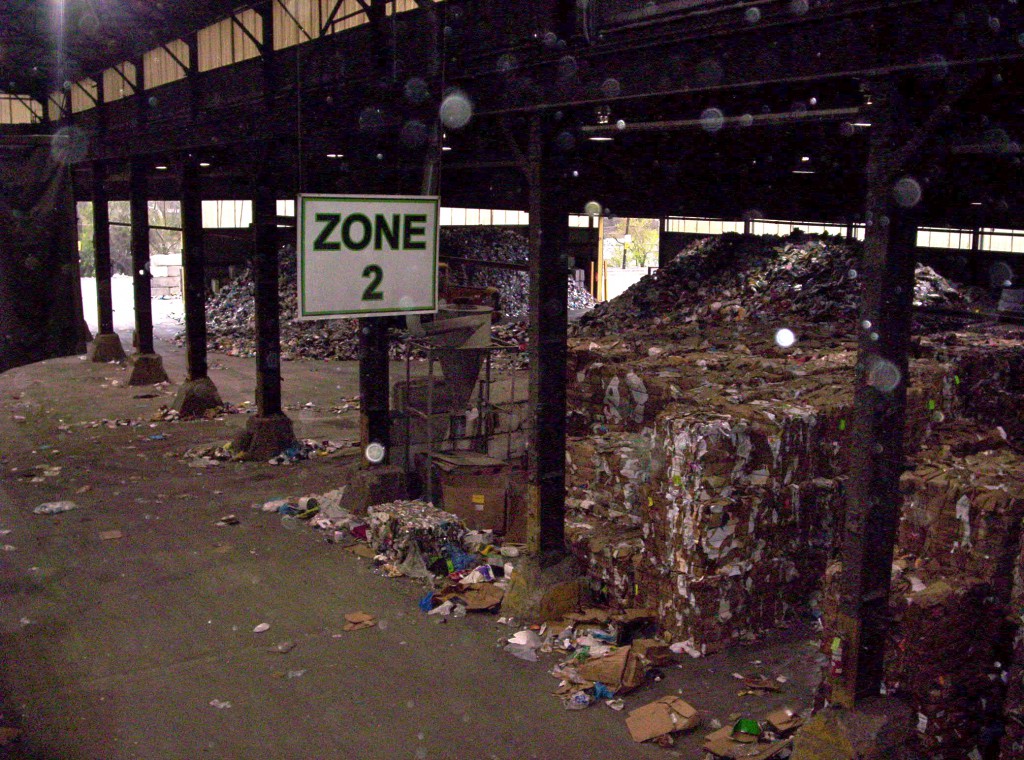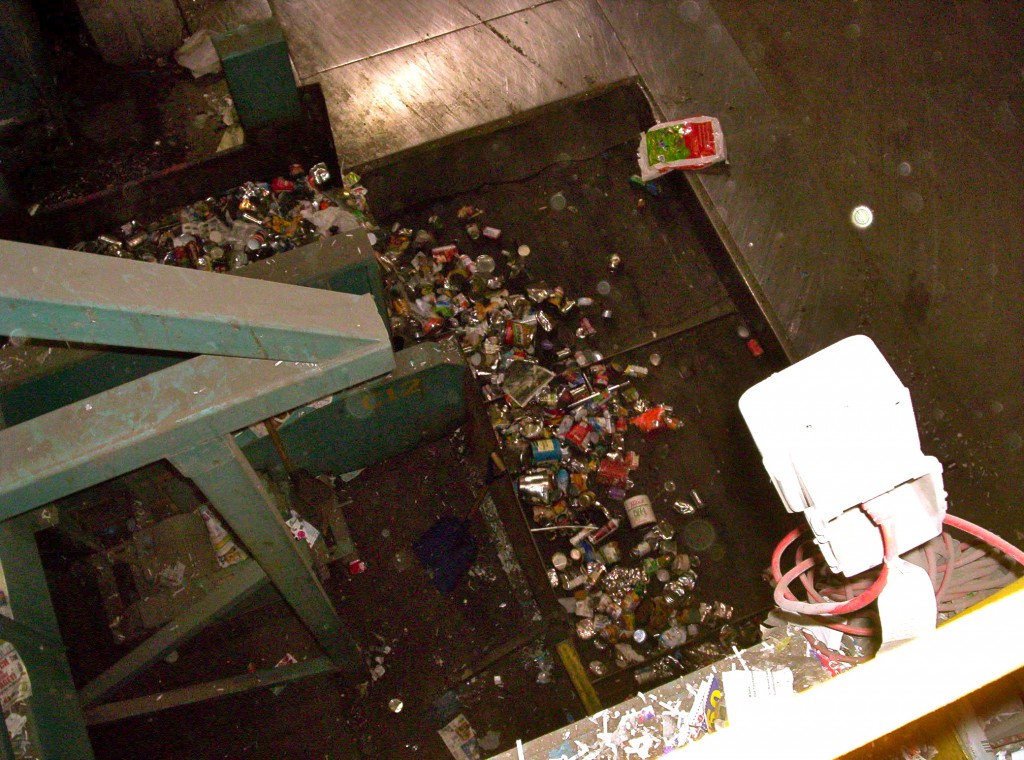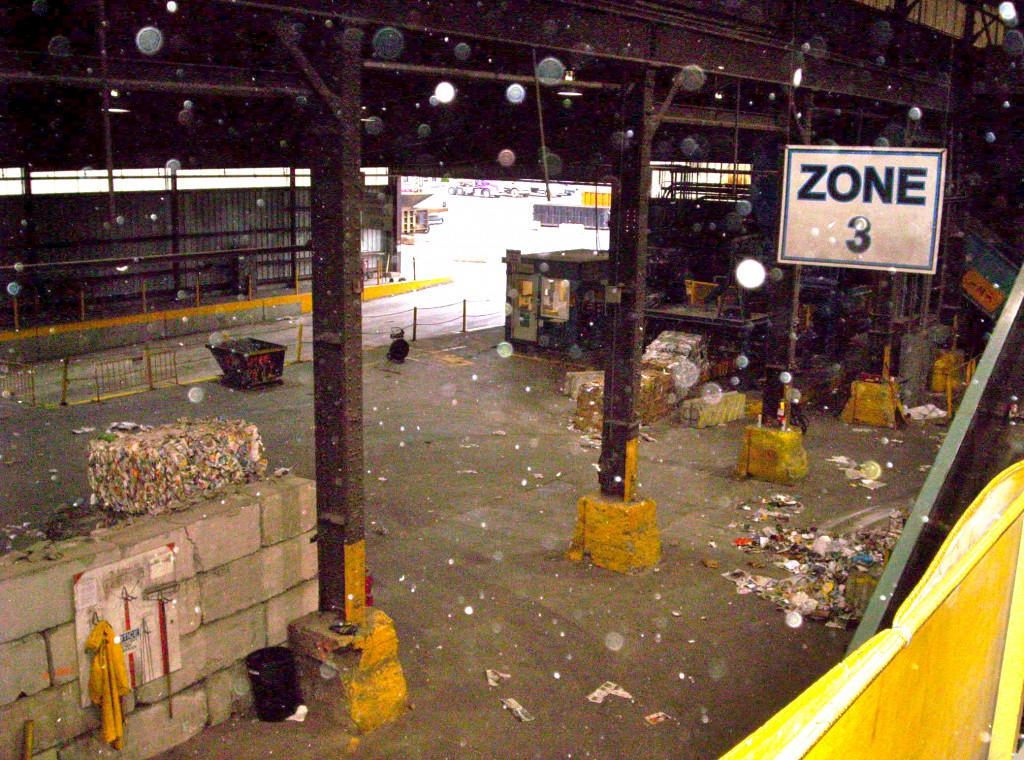Get the double meaning there? About a year ago, I wrote a post called “Green Star Rising,” telling you all about my new job. That star is “setting” now, serenely and with lovely grace, as I count down my last little while at the plant. And “setting” is also the place where a story happens. Yes, here is a look at the setting — a glimpse behind the “Green Curtain.”
The photo above shows where I’ve stood for most work days of the past year. My place is between that wheeled trash bin and the orange-rimmed chute. Ralph used to stand right across the belt from me. You can see the coding instructions on the sign: “comingle” is what comes at us, but it’s also the chute down which we throw all cans and bottles, regardless of the material they’re made of. They go on from there to guys who sort them more specifically. Because there’s not a red “trash” chute near me, I have to put my trash into the bin and dump it whenever it gets full into a red chute farther back along the line. You’d be amazed at how quickly even this large bin fills up.
Here, you can see my gloves on the handle of my trash bin. There are inner wool gloves (probably synthetic wool) and outer, tough gloves capable of withstanding the jagged edges of broken glass and torn metal. But these are still the lightweight gloves of the plant. The guys who handle the stuff as it first comes in from outside wear gloves that are actually armored. Those are the men who might face engine blocks, decomposing deer, unexploded contact bombs from the war, alien spacecraft . . .
So Ralph used to work on the far side of this near belt. Behind him, back-to-back with him, Punkin used to stand at the far belt in the position corresponding to mine. Yum-Yum stands there now.
It appears to be snowing in these photos. That’s the camera’s flash reflecting off dust-motes in the air. You can’t normally see them. I was rather startled when I saw these pictures. This is what we’re breathing at the best of times. This was before the work day started, when the machinery wasn’t moving, when tons of comingle weren’t roaring through the system, bouncing and kicking up clouds, bags and containers rupturing open, spewing stenches and powders into the air. Sometimes a cloud envelops us, and we simply hold our breath for awhile; sometimes it’s so thick and prolonged that we have to step away from the belt until it dissipates, and we take little breaths from the direction away from the cloud source. Most clouds, however, don’t have a clear “source” . . .
So here I am, waiting for the belt to start up. Spider is checking his list and seeing if it matches up with who’s present. He’s counting guys on our deck and sending more up if we need them. It’s four men to a belt, eight on our deck.
Our required gear: hardhat, high-reflectivity shirt or vest, gloves, plastic eye-protecting glasses, and ear plugs.
Here, my friend and co-worker Jeff displays a magazine gleaned from the comingle. As Ralph always said, “The line provides.” Many of the guys typically refer to such magazines as “books,” as in, “Hand me that book!” It’s a good euphemism, I guess. But I do wonder what they think, knowing that I write books. Hmm . . .
Ralph called them “catwalks”; Gizmo called them “landings”; I’ve also heard them called “balconies”: they are the access ways that traverse the plant’s depths two, three stories and more above the main floor. When the machines go down, when we’re sent for cleanup at odd times, I generally start by climbing over my railing and cleaning off this catwalk (visible here at the bottom of this red ladder). It’s quite clean in this photo. I must have been down there! At the far end of this one and up a ladder to the left, you can reach The High Place.
This is just to the left of where I stand. If I look down over my railing, this is the view. I also frequently stand on those girders and sweep them off. A lot of the cleanup involves tugging shreds of plastic and paper out of tight places where it lodges as it floats downward. This debris accumulates like this because it spills over the edges of the belt on its journey up to us. The main area I always clean up at the day’s end is this floor here, beneath our deck.
This is my favorite chute in the plant. This is where the boxes go: corrugated cardboard, cereal boxes, beer boxes, paper egg cartons, and all such like. It’s open on the east somewhere far below, and sometimes early sunlight slants into it from the side, lighting up the depths of it with a glow that’s rosy at first, then orange, like the paint on its rim. If one went far enough down this shaft, I suppose one would eventually come to the River Styx, where Charon poles his boat eternally through the mists, taking cardboard to the land of the dead.
Here’s my line leader, Yum-Yum, a good-hearted man. He often announces his arrival on the deck by singing a sustained, operatic note that echoes through the cavernous spaces. His nickname comes from his bag of edible provisions, which he generously gives to hungry souls. On the rare occasions when Yummy is away, some guys don’t eat. Lord, bless Yum-Yum!
That’s a grape drink Yum is holding. Here, you can see the difference in garb between a temp worker (left) and a full-time employee of the company (right).
Here’s what we do with the large pieces of (mostly) metal that come crashing down at us — the lawnmower blades, license plates, Giant Eagle swords, car parts, bases of fans, etc. If we can locate the thing that hit the belt, we drag it off the belt and drop it here, from where the line leader eventually takes it downstairs. The plant can sell such items as scrap metal. You can see why I keep my hardhat on, working in the point position. All of this scrap you see here is stuff that has come rumbling over the apex of the belt above me and down onto our belt — sometimes beneath the protective hood, sometimes outside it. When we hear a crash, it’s sometimes impossible to find what made the sound, since it might be buried under the other comingle on the belt.
And here’s our product: here’s what comes out of the mighty baler. These are stacked blocks of mixed paper with all the junk and other recyclables sorted out of them.
See the large space at the back of the building, beyond the bales? This is the tipping floor, where the payloaders and trucks bring in the comingle. High as the mountains of it are, back under the old management, we would occasionally run out; now, as I understand it, there are more contracts for it, and an inexhaustible supply. This is the capital city of My Man the Rat.
So there you have it: a look inside. It’s been a great year. As my college friend David M. once told me: “Great adventures are not always easy; but they are always worth it.” Wise words.
This is looking down from our paper line toward the office — the cubicle in about the middle of the picture. The dumpster in the top left is for wire. And the dust rains forever down on the just and the unjust alike . . . or else those are orbs, and this is a very haunted plant — haunted by the ghosts of a thousand temporary workers and legendary old full-timers, all wandering the floors and catwalks in search of a rake or broom, waiting for the call to break time or lunch, or best of all, the shift’s end. Dona eis requiem. Their voices echo, telling of exploits, swapping stories to outdo one another . . . joking, laughing, singing long notes . . . and ever, the engines growl and the trucks bring more comingle, always more; and the rats in their deep cities find what they can find.
